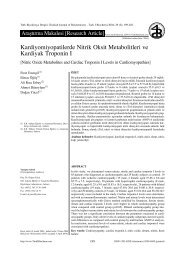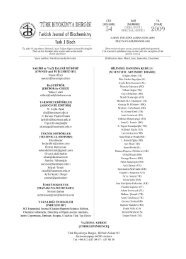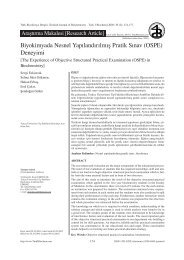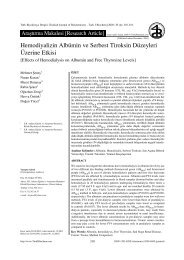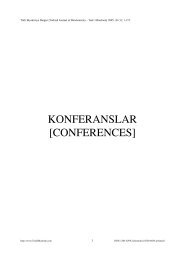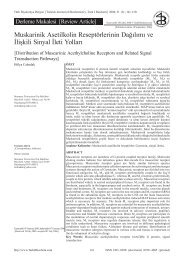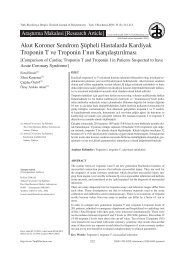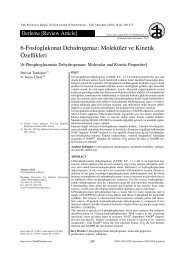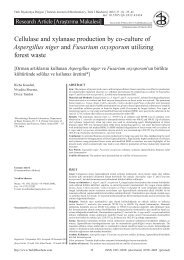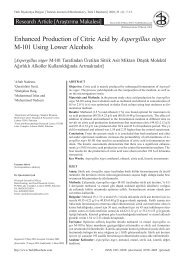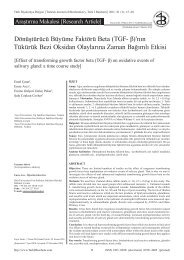24. Ulusal Biyokimya Kongresi - Türk Biyokimya Dergisi
24. Ulusal Biyokimya Kongresi - Türk Biyokimya Dergisi
24. Ulusal Biyokimya Kongresi - Türk Biyokimya Dergisi
- No tags were found...
You also want an ePaper? Increase the reach of your titles
YUMPU automatically turns print PDFs into web optimized ePapers that Google loves.
XXIV. ULUSAL B‹YOK‹MYA KONGRES‹<br />
25 - 28 Eylül 2012<br />
Dedeman Otel - Konya<br />
<strong>24.</strong> <strong>Ulusal</strong> <strong>Biyokimya</strong> <strong>Kongresi</strong>, Konya [24 th National Biochemistry Congress, Konya / TURKEY]<br />
İÇİNDEKİLER<br />
DAVETLİ KONUŞMACI ÖZETLERİ<br />
kontrol edilemeyen ya da asla tanımlanamayan olası hata türleri daima olacaktır.<br />
Laboratuvarda kontrol edilemeyen koşulların sayısını en aza indirmek amacıyla<br />
çaba harcanmalı, böyle durumlar için hazırlıklı ve planlı olunmalıdır. Kontrol<br />
edilemeyen koşulların saptanması amacıyla stabil kalite kontrol materyallerinin<br />
düzenli ölçümlerinin yapıldığı istatistiksel kalite kontrol (QC) prosedürleri yıllardır<br />
başarıyla kullanılan yaklaşımlardır. Stabil kalite kontrol materyallerinin düzenli<br />
ölçümlerine dayanan bir kalite kontrol stratejisinin tanımlanması sayesinde şu üç<br />
soru yanıtlanabilir:<br />
1) Kalite kontrol değerlendirilmeleri ne zaman planlanmalıdır<br />
2) Ölçülecek kalite kontrol örneklerinin sayısı kaç tane olmalıdır<br />
3).Test sürecindeki kontrol edilen ve edilemeyen koşullara karar vermek için kalite<br />
kontrol sonuçlarına hangi kalite kontrol kuralları uygulanmalıdır<br />
Bu soruları yanıtlamak suretiyle kalite kontrol stratejisinin performans özellikleri<br />
kantitatif olarak değerlendirilebilir. Farklı sonuç ölçümleri ile hesaplamalar<br />
yapılabilir. Ancak, Şekil 1’de gösterilen hastaya zarar verebilecek olaylar<br />
dizisindeki tüm aşamalara en iyi uyan hesaplama yöntemi, belirli tip ve<br />
büyüklükteki kontrol edilemeyen koşullar nedeniyle oluşan ve raporlanan hatalı<br />
hasta sonuçlarının olası sayısının saptanmasıdır.<br />
Olasılık ve Şiddetin Değerlendirilmesi<br />
Hatalı bir sonuç rapor edildikten sonra hastaya zarar verme olasılıkları üzerinde<br />
tıbbi laboratuvarların kontrol edebilme gücü düşüktür. Tıbbi laboratuvarlar analit,<br />
hasta popülasyonu ve tıbbi değerlendirmelere göre bu olasılıkları hesaplayan en<br />
üst çabaları göstermelidir. Aynı şekilde, hatalı bir laboratuvar sonucundan dolayı<br />
bir hastaya verilen zararın şiddeti analite ve hasta popülasyonuna bağlı olacaktır.<br />
Zararın şiddeti, sonuçların kullanılabildiği çeşitli evrelerin değerlendirilmesini<br />
gerektirir. Farklı şiddet derecelerine neden olan birçok senaryo mümkün olduğu<br />
takdirde, laboratuvarda en olası ve en yüksek şiddette zarara yol açacak senaryolar<br />
düşünülmelidir. EP23-A kılavuzunda beş farklı ayırt edici sınıflandırma<br />
kullanılarak bir şiddet ölçeği örneği sağlanmaktadır:<br />
• İhmal edilebilir Geçici rahatsızlık ya da zorluk<br />
• Minör Geçici zarar ya da tıbbi uzmanlık girişimi<br />
gerektirmeyen kötüleşme<br />
• Ciddi Zarar ya da tıbbi uzmanlık girişimi gerektiren kötüleşme<br />
• Kritik Kalıcı kötüleşme ya da yaşamı-tehdit eden zarar<br />
• Katastrofik Hastanın ölümü<br />
Risk Yönetimi, İstatistiksel Kalite Kontrol<br />
Risk yönetimi risklerin tanımlanması, değerlendirilmesi ve öncelikli olanların<br />
failure modes that are never identified or that cannot be adequately controlled at<br />
the point of failure. A lab should strive to minimize the number of out-of-control<br />
conditions created but plan for their ultimate presence, as eventually something<br />
unexpected will happen that causes an out-of-control condition.<br />
Statistical quality control procedures based on the periodic measurement of stable<br />
QC materials is the approach that has been successfully employed for decades to<br />
detect out-of-control conditions. Defining a QC strategy based on the periodic<br />
measurement of stable QC materials involves answering three questions:<br />
1) When to schedule QC evaluations,<br />
2) How many QC samples to measure and<br />
3).What QC rule(s) to apply to the QC sample results to decide the in-control or<br />
out-of-control status of the testing process?<br />
Given the answers to these questions, the performance characteristics of the QC<br />
strategy can be quantitatively assessed. Different outcome metrics can be computed,<br />
but the outcome metric that best fits into the overall model of the sequence of<br />
events that can lead to patient harm depicted in Figure 1 is the expected number of<br />
incorrect patient results produced and reported due to an out-of-control condition<br />
of a given type and magnitude.<br />
Assessing Likelihood, Severity<br />
Even though the lab has little control over the probabilities leading to patient<br />
harm after an incorrect result is reported, the lab should make its best attempt<br />
at estimating these probabilities based on the analyte, patient population and<br />
medical judgment. Likewise, the severity of harm to a patient resulting from an<br />
incorrect lab result will depend on the analyte and the patient population. The<br />
severity of harm requires assessment of the various ways the results may be used.<br />
If multiple scenarios leading to different degrees of severity are possible, the lab<br />
should consider the most likely and most harmful scenarios. EP23-A provides an<br />
example of a severity scale using five descriptive categories:<br />
• Negligible<br />
• Minor<br />
• Serious<br />
• Critical<br />
• Catastrophic<br />
inconvenience or temporary discomfort<br />
temporary injury or impairment not requiring professional<br />
medical intervention<br />
injury or impairment requiring professional medical intervention<br />
permanent impairment or life-threatening injury<br />
patient death<br />
Risk Management, Statistical QC<br />
Risk management is the identification, assessment, and prioritization of risks<br />
followed by coordinated and economical application of resources to minimize,<br />
CONTENTS<br />
ABSTRACTS OF INVITED LECTURES<br />
Turk J Biochem, 2012; 37 (S1)<br />
http://www.TurkJBiochem.com



